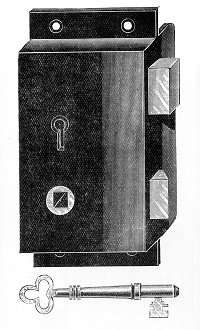
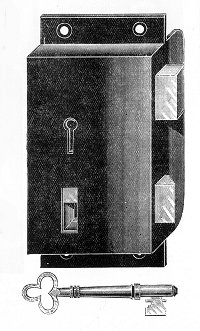
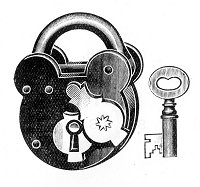
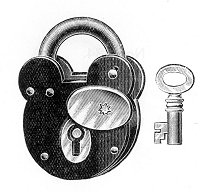
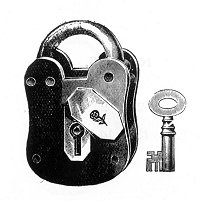

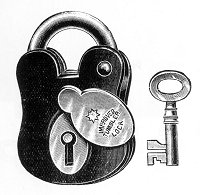
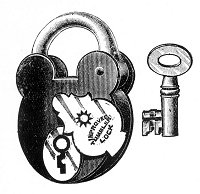
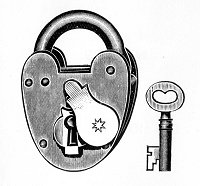
|
In 1865 we have, thanks to J. C. Tildesley, a slice in
time picture of the local industry.
Tildesely’s main classification of the lock trade is into
the trade of Wolverhampton and that of Willenhall. Clearly they are both
important trades in their own areas but he does not suggest that the
scale of manufacturer is noticeably greater in one town than in the
other. But he does see some clear distinctions between them. The first
is that in Wolverhampton the locks are based on tumblers and levers and
in Willenhall and elsewhere they are based on wards. Secondly the locks
produced in Willenhall are "of inferior quality". Thirdly the lock trade
in Willenhall is divided amongst "many masters, the majority of whom
employ only some six or eight men or boys". This has resulted in
considerable competition, exploited by purchasers to drive prices down,
so that "excellence of workmanship has given way to rapidity of
production". The implication is that Wolverhampton’s lock industry is
based on much larger firms, though the only one which gets a mention is
Messrs. Chubb and Son.
Brewood, Coven and Pendeford also get mention as making
the ironwork for fine plate locks, which are completed in Wolverhampton.
Short Heath and New Invention make cabinet locks "but the articles
produced are much inferior to Wolverhampton make". The lock trade in
Walsall "has much extended in recent years" and Wednesfield is noted as
making some locks as well as keys, but in both places "the lock trade is
only a supplementary brand of industry".
At this time, Tildesely records, the principal overseas
markets are Australia and New Zealand. India is a large market for
padlocks. And the Continent provides a market for brass and ornamental
padlocks. The United States used to provide a considerable market, more
than half the locks made in the district being sent there. But now their
home industry was expanding and trade to the US was declining. But "the
development of new empires, and the opening up of fresh fields of
commerce in our colonies, augur well for this department of local
industry".
There was foreign competition, mainly from America, France
and Germany. The Americans use very fine casting sand which does away
with the need for any filing of the castings, which enables locks to be
made ten times faster. But their locks "are unenduring and insecure" and
are little threat outside the USA. Continental locks are no better.
Although they are elaborately decorated, they lack "the strength and
practical usefulness" of English locks.
Even though Tildesley thinks it will take some time
"before the French consumers will abandon their own flimsy decorative
articles in favour of plain practical English locks" the example of
these fancy foreigners does give Tildesley some cause for concern:
"neither …have locks and keys made in this district kept pace with the
demand for decorative art workmanship, which is the natural result of
the refining influence of an increasing civilisation, and the spread of
education amongst the people". And "it cannot be denied … that Mr.
Ruskin’s theory, on the union of art and handicraft, might he studied
with advantage by the locksmiths of this district, to whose productions
might be given increased symmetry and beauty, without in any way
destroying their more practical qualities."
He also says that "perhaps no extensive branch of local
industry has taken less advantage of the recent progress of mechanical
science than the lock trade. In most cases, they are constructed now in
precisely the same manner as they were twenty years ago. To the fact of
the trade being so much in the hands of small capitalists, must be
mainly attributed the lack of that enterprise and progression which have
characterised other departments of local industry".
The lives of those working in the industry also has his
attention, where he finds that things have "much improved of late years,
but there is still room for amendment". Working hours were from 6 a.m.
to 7 p.m. in winter and from 7 a.m. to 8 p.m. in summer "but in too many
instances those hours are exceeded". Only 10% of the workforce is women
but the widespread employment of boys under the workhouse apprenticeship
system causes concern, though there is less of it than there used to be
and the boys are better treated.
Generally the blacksmiths work much better than they used
to, even though they still drink the health of St. Monday – that is,
they do not work on Monday, turning Sunday and Monday into a week end
break. But they have taken advantage of the facilities for
self-improvement offered to them and "in one lock factory, which may be
taken as a fair example of the others in the district, 70 per cent. of
the artisans are members of Friendly Societies, 50 per cent. can read
and write, 15 per pent. are members of a Mechanics’ Institute, 10 per
cent. have accounts with the Post Office Savings Bank, and 5 per cent.
are the owners of the freehold cottages in which they reside."
Tildesely, who is not averse to including local folklore
in his account, does not mention one still-remembered feature of
Willenhall lock workers. They were said to spend so much of their lives
hunched over a bench that they developed a permanent distortion of the
spine. So many men were so afflicted that Willenhall was known as
"Humpshire" and, it is even said that the pub benches had hollows in
their backs to accommodate the humps. But no evidence of this curious
furniture has ever been found.
Many years later, another Tildesley, Norman W. Tildesley,
adds a few details (in his History of Willenhall, Willenhall UDC, 1951,
published "to commemorate the Festival of Britain") adds a few details,
apparently from the same period. "The locksmiths were assisted by their
wives and members of their families, together with one or two
apprentices. Children in those days were set to work at the tender age
of nine or ten years. They were first taught how to file and humped
backs and twisted shoulders were the result of this early training. A
considerable number of these children were placed as apprentices by the
parochial officers. The lot of the parish apprentices was indeed a
grievous one. Many of these lads came from the Tamworth Workhouse and at
ten and eleven were apprenticed to the lockmakers to spend the next ten
years as members of their households. Many of the masters were harsh and
unscrupulous and looked upon these unfortunate children as a form of
cheap labour which they could exploit to the full. The small cramped
workshops, hard work, long hours and poor food wrought havoc with their
frail bodies and the death rate amongst them was high, many of them
perishing from consumption and other kindred complaints". Bad though
this may be, it is worth remembering that the locksmith’s own children
may have fared no better and the apprentices became part of a whole
household that was barely scraping a living.
|